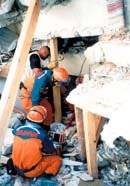Official Development Assistance (ODA)
5.Japan Disaster Relief Teams Help Rescue a Trapped Survivor of an Earthquake in Northwestern Turkey
A powerful earthquake measuring 7.4 on the Richter Scale and centered in Izmit, about 110 km east of Istanbul, struck northwestern Turkey just after 9 a.m. (Japan time) on August 17, 1999. The major tragedy left 14,202 dead and 25,254 injured (figures published by Turkey's Disaster Relief Headquarters as of August 31). Responding to Turkish government appeals for assistance, Japan immediately decided to send Japan disaster relief teams, the first contingent of which departed Japan on the evening of the same day.
The rescue team consisted of 39 personnel, the mainly from the Fire-Defense Agency and Maritime Safety Agency. Of those, the first 20-person contingent arrived in the devastated area 41 hours after the quake and quickly began searching for and providing relief to victims. Conditions immediately after the quake were bad: basic lifelines, including electric power, water, and communications, had all been cut off. However, for a five-day span, the Japanese team worked at an intense pitch to find and rescue survivors of the quake, making full use of a variety of high-tech tools, including fiberscopes (flexible fiber-optic cabling with attached cameras that facilitated the search for trapped victims through narrow openings in the rubble), sound sensors (capable of detecting sounds emanating from beneath the rubble), and life sensors (which utilize magnetic fields to pick up the faint heartbeats of buried survivors).
On the morning of the second day of their activities (August 19), they received information from local police that a survivor had been found. Five team members were rushed to the scene, where they discovered a survivor under the rubble of a collapsed building, pinned between a bed and a concrete panel. After calling in reinforcements, the Japanese team began using its tools to break through the rubble, while Japanese paramedics and local doctors provided care. The instant the survivor was freed, loud applause emanated from the crowd of some 400-500 local citizens who had gathered to watch the rescue.
The survivor was Melahat Ozkurt, a 74-year-old woman who had been trapped under rubble once before, in a quake that struck northern Turkey 60 years earlier. In effect, this was her second "miracle rescue."

Emergency relief team members in action (in Turkish city of Yalova).
Since its establishment, the Japan Rescue Unit has been deployed overseas a total of six times, including a January 1999 mission to rescue earthquake victims in Colombia. This rescue in Turkey was the unit's first rescue of a survivor from the rubble. Though many factors had an influence on the effective rescue activities of the Japanese team, the fast response was without question the most important. Despite the fact that Japan is a country quite distant from Turkey, the first contingent departed from Narita Airport only five-and-a-half hours after Japan received the assistance request from Turkey, arrived on the rescue scene within 41 hours after the quake, and immediately initiated rescue operations over a wide area.

Emergency relief team members in action (in Turkish city of Yalova).
